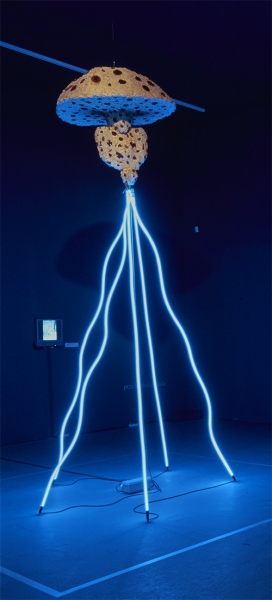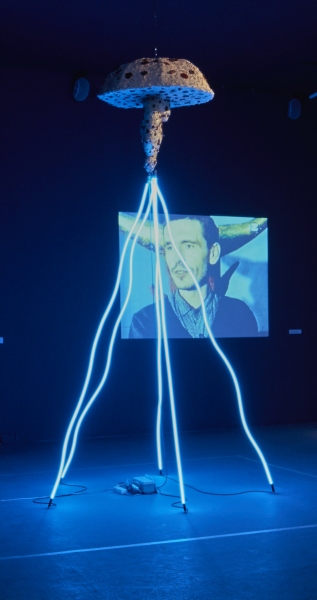Marek Kijewski
Flint from Siberia
Like most of Marek Kijewski’s works, the sculpture encompasses various cultural codes. It resembles a flying saucer, a spaceship or a mushroom. It consists of a a white canopy of feathers embedded in resin covered with dried toadstool hats and a luminous tail made of blue neon lights.
Flint is a stone used by primitive peoples to kindle a light and warmth-giving fire. However, the peoples of Siberia treated fire not only as a way to illuminate the real world, but also as a means to enter the spiritual world. The shamans provided the link between the tribal communities and the spiritual world. They held a unique position in these communities – not only were they knowledgeable about medicinal plants, but also explained the general order of the world and were able to connect with spirits when they entered into a trance, achieved thanks to hallucinogenic plants. The consumption of specially prepared amanita muscaria, the sacred mushroom and the most iconic toadstool species was especially appreciated. It opened the way to the fulfilment of religious practices and journeys in the spiritual world.
Kijewski’s work may resemble a toadstool with inverted colours – white with red dots – as a reference to archaic shamanic practices. In contrast, the blue light creates a shape similar to a modern rocket launched into the sky. The artist combines ideas from completely different orders: the spirituality of traditional cultures and the products of technical civilization into one suggestive whole. An ecstatic and subjective exploration of the cosmos, carried out with the use of hallucinogenics, coexists with components relating to modern exploration of interplanetary space, based on the scientific understanding of the laws of physics. Even if the image of such connection seems unreal and fantastical, it convincingly suggests the kinship of the cognitive desires of people belonging to completely different civilizations.
Marek Kijewski is the creator of numerous sculptures that go beyond the traditional understanding of this medium. Often, his works have drawn attention to alchemical and mystical inquiries based on ancient myths or themes from contemporary popular culture. His use of intense colours to his sculptures – blue, red and white – follows their symbolic understanding taken from the writings of the Orthodox theologian Paweł Florenski. Blue symbolises heaven, red – fire, energy, strength, power, and beauty, goodness, martyrdom and love, while white is the sign of divinity.

